National Gallery Singapore presents Kim Lim: The Space Between. A Retrospective; an exhibition honouring a modern art pioneer from Singapore
Rediscover the quiet brilliance of master sculptor and printmaker Kim Lim in the most comprehensive major museum showcase of her works to date
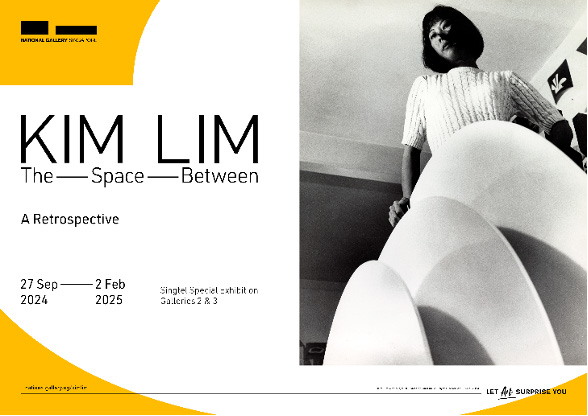
National Gallery Singapore presents Kim Lim: The Space Between. A Retrospective – the most comprehensive museum survey to date of Singapore-born British artist Kim Lim’s work. This landmark exhibition is organised into four thematic and periodic sections, each highlighting Lim’s predominant aesthetic preoccupations of the time. The exhibition is the third installment of the Gallery’s four-part SG Artist series.
Opening on 27th September 2024, Kim Lim: The Space Between. A Retrospective marks the first rigorous attempt to reposition Lim as a major figure in 20th-century sculpture and printmaking. Unprecedented in its scope, the exhibition features over 150 works, including critical sculptures and prints spanning four decades, as well as maquettes, never-before-seen photographs, and archival materials. The artworks and archival materials provide fresh insights into Lim’s artistic journey, philosophy, and creative relationships and showcase how she used the power of suggestion and metaphor to masterfully balance light, space, and rhythm to great effect.
Dr. Eugene Tan, CEO and Director of National Gallery Singapore says, “We are honoured to celebrate the life and work of Kim Lim, an extraordinary Singapore-born artist who has contributed to global art histories. Leaving Singapore for London at just seventeen, Lim gained considerable recognition for her art during her lifetime. She developed a distinctive Minimalist artistic language, informed by her travels between Europe and Asia and marked by subtlety, resolve, and occasional playfulness, offering a counterbalance to the male-dominated sculptural traditions of the 20th century. However, like many artists who moved abroad, Lim's contributions were sometimes overlooked until recently. Since its opening in 2015, the National Gallery Singapore has presented Lim’s artworks in various exhibitions, with the view that a retrospective for her was imperative. As such, Kim Lim: The Space Between. A Retrospective attempts to remedy the historical exclusion of female artists from art history. The time to rediscover Kim Lim is now.”
Alex and Johnny Turnbull (Estate of Kim Lim), say, “We are honoured to see our mother, Kim Lim, celebrated in this major retrospective at the National Gallery Singapore. Although she spent much of her artistic life in the UK, she remained deeply connected to Singapore and Asia, which is also vividly evident in her artworks. We are thrilled by the growing international recognition of her artistic legacy and are proud to have this comprehensive exhibition of her work in Singapore, where her art and remarkable life can continue to inspire and resonate with new audiences.”
Mr Yuen Kuan Moon, Singtel Group’s Chief Executive Officer, says, “Singtel is proud to support this landmark retrospective on the visionary artist, Kim Lim. As a company with a strong heritage closely interwoven with Singapore, we recognise the importance of nurturing and celebrating our arts and artists. This exhibition is a testament to the high calibre of art talents emerging from Singapore and their ability to stand on the global stage. We are honoured to partner with National Gallery Singapore to bring works of key figures in art history to the public and contribute to a greater appreciation of their influence.”
Kim Lim, master sculptor and printmaker
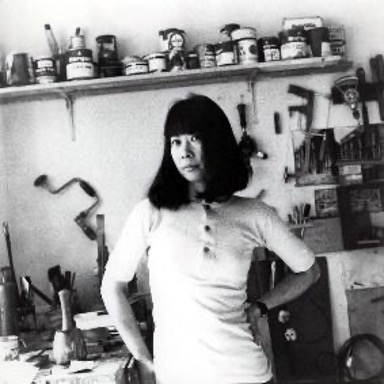
Kim Lim (1936–1997) belonged to the first generation of diaspora and immigrant artists who moved to the United Kingdom after the Second World War to pursue art education. In 1954, she left Singapore for London to study at the St. Martin’s School of Fine Art and later at the Slade School of Fine Art.
Throughout her career, Lim pursued printmaking and drawing in tandem with her sculptural work, moving between these disciplines with material and technical agility. Although her aesthetic sensibilities evolved, her works are connected by her enduring interest in the language of abstraction and the qualities of light, space, and rhythm.
During her years in Britain, Lim resisted the cultural signifiers often used to frame her life and work. As a foreign female artist working in a male-dominated art world, she refused to let others define her art through narrow lenses. Her practice results from a balance between references and resistance to dominant Euro-American discourses on Minimalism and abstraction.
Enriching her formal education through her extensive travels across Europe, East Asia, and Southeast Asia, Lim drew from diverse sources of inspiration to develop a distinctive visual language. Immersed in the diverse material cultures and architectural sites she encountered during her journeys, Lim’s art reflects her transcultural experiences and sensibilities. This unique approach earned her recognition within local and international art circles during her lifetime. Although Lim’s work was overlooked for some time following her untimely passing, recent major institutional shows, such as those at Tate Britain (2020-2021) and Hepworth Wakefield (2023-2024), have sparked a global revival, underscoring the continued relevance and resonance of her rich artistic practice today.
Introducing the foundations of Lim’s artistic explorations in Early Works: Assembling, Delineating
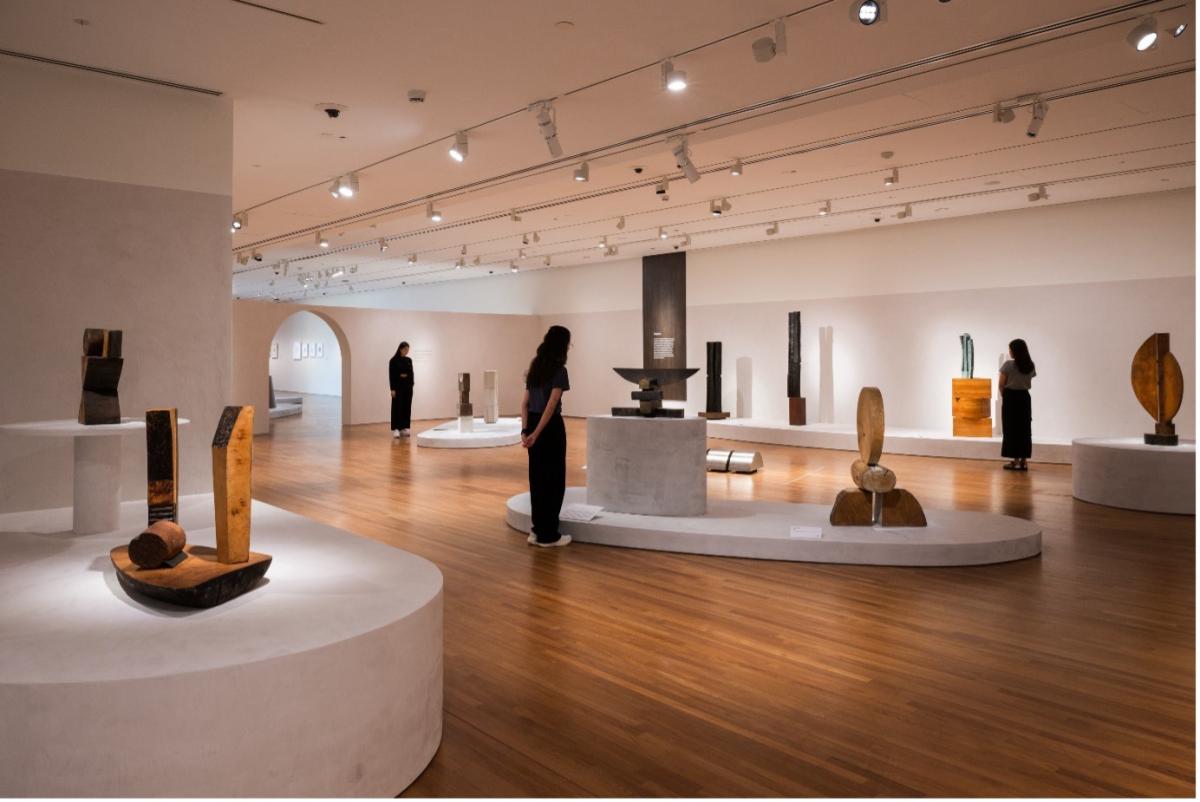
The exhibition opens with Lim’s early works, revealing how vertical and architectonic structures have been key sculptural forms since her student years. Lim explored diverse methods of delineating surfaces and constructing verticality, including stacking, segmentation, and alternation, to develop a rhythmic range of columnar expressions. Encountering Romanian pioneering artist Constantin Brâncuși’s sculptures through books was formative to her sculptural sensibility. The titles of her early works, such as Samurai (1961), Pegasus (1962), Ronin (1963), and Centaur II (1963), suggest her interest in elemental and archaic forms. These explorations laid the foundation for her enduring focus on the spatiality and scale of abstract forms, which continued to shape her practice throughout her career.
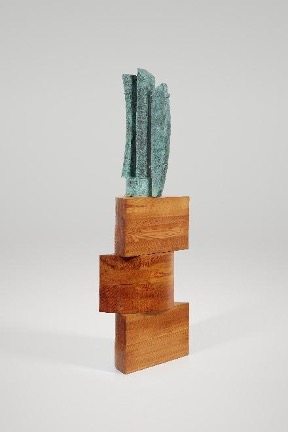
Lim deliberately forewent traditional plinths, placing her sculptures directly on the floor to suggest that they rise from the ground rather than be merely supported by it. Pieces like Centaur II (1963) exemplify her early mastery of form and material through their verticality and balanced composition. In the 1960s, when women sculptors like Lim were underrepresented in a sculptural scene dominated by hypermasculine ideals, Centaur II introduced a delicate and nuanced interpretation of strength and height. The sculpture’s dynamic interplay of slender, teal-green, bronze stalks rising from a stack of alternating curved wooden blocks sharply contrasted with the era’s emphasis on masculine power and solidity.
This first section offers visitors insight into the evolution of Lim's formal interests, showcasing her column-based sculptures as a recurring signature style throughout her career. Her continual revisiting of these forms with fresh perspectives reveals her cyclic working method and provides visitors with a deeper understanding of her artistic journey.
Lim’s bold shift to industrial materials in Keen Edges, Eccentric Colour
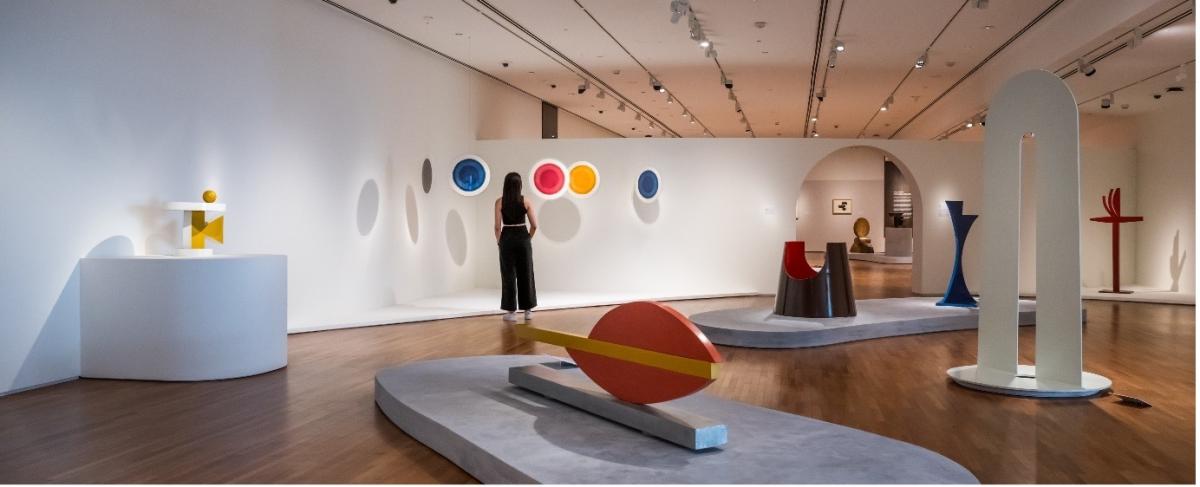
After Lim’s student years, she moved away from traditional sculptural methods and moved to industrial materials such as engineered blockboard, steel, aluminium, and fibreglass for her sculptures. She also sprayed brightly coloured industrial paint onto her sculptures, which gave them a uniform and flat finish that concealed the materials’ natural textures and characteristics. This approach accentuated the geometric precision of her forms and planes, highlighting her ability to achieve expressive effects through restrained and deliberate means.
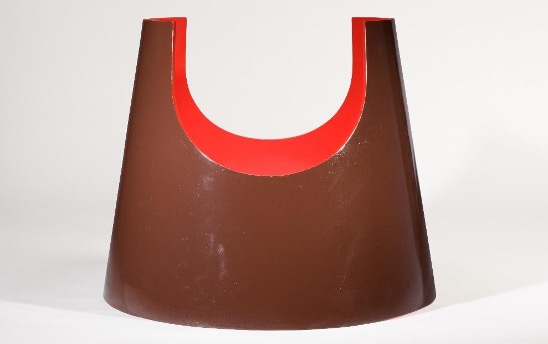
During this period, Lim wanted to “make a clear, unfussy statement of form” and focused on formal qualities such as colour, edge, and negative space. In Echo (1967), the contrast of its vivid vermillion interior against its exterior’s deep magenta emphasises the sculpture’s form, drawing the viewer’s focus to the sculpture's edges. The piece simultaneously contains and negates space to present negative volume without relying on mass or bulk. Its squat form and sharp edges contrast with Lim’s earlier tall, upright works, using its rounded contours to manipulate space and its surfaces to highlight its shell-like quality and flatness.
Unveiling Light, Space, and Rhythm as sculptural materials
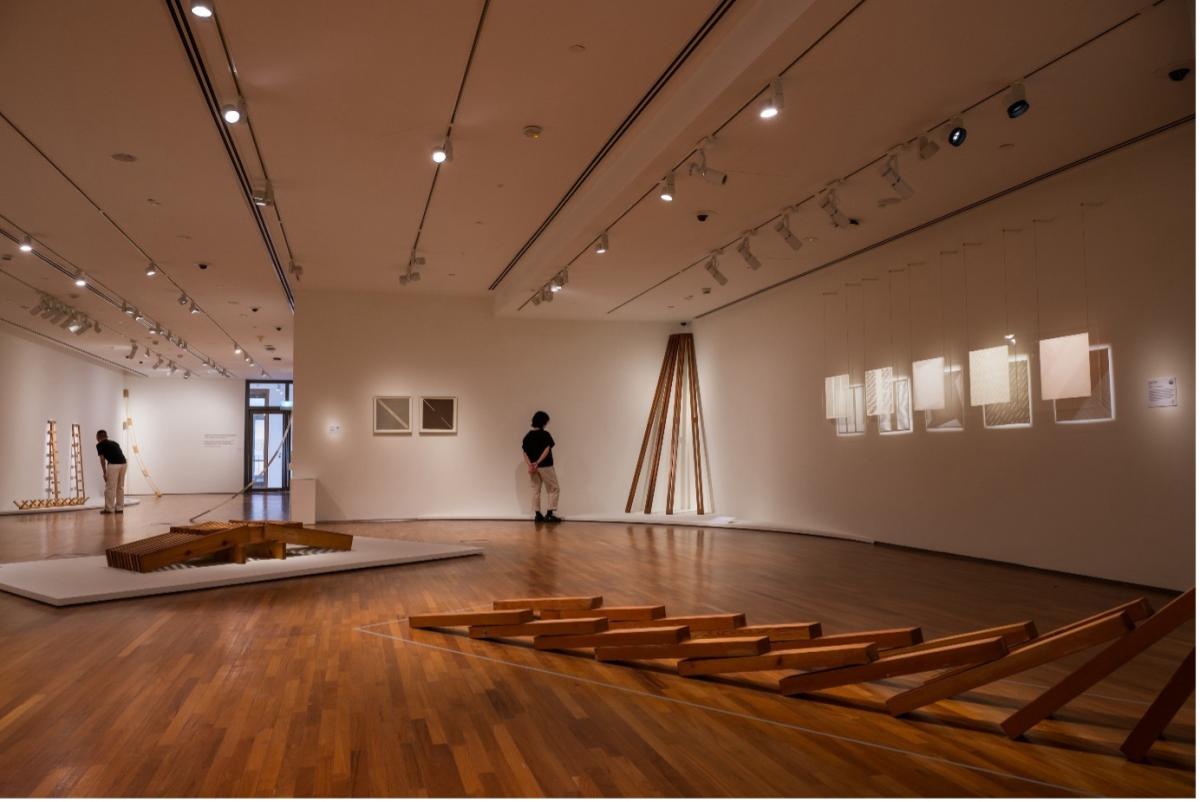
The exhibition's third section, which begins in Singtel Gallery 2, focuses on Lim’s profound exploration of light and space rather than the traditional emphasis on mass and volume. During the mid-1960s to 1970s, Lim adopted a serial and modular approach to sculpture, utilising materials like wood and aluminium to create basic units that can be arranged to cast varying shadow patterns. Her work from this period shifted their loci from the structures themselves to the “spaces in-between”, allowing light and space to play significant roles in shaping the appreciation of her works.
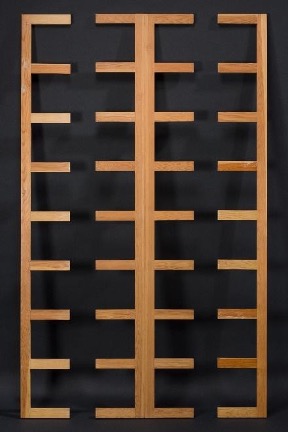
A key feature in this section is the coming together of Lim’s Intervals series (1973) from the National Collection and the Tate Collection to showcase various possibilities for configuring the work. The series features ladder-like wooden structures, each with spines and prongs. Devoid of a clear orientation — top, bottom, front, or back — works from the series may be arranged according to configurations predetermined by the artist.
When propped against walls or laid supine on floors, the structures are carefully lit to cast shadows that echo their forms, multiplying their lines of rhythm. Lim used space, or “intervals” as the title suggests, to transform light and space into sculptural elements, highlighting the significance of the negative “in-between” spaces, revealing her structures' endless possibilities as visitors move around and encounter them from various angles.
Feel The Weight of a Line in Lim’s stone sculptures
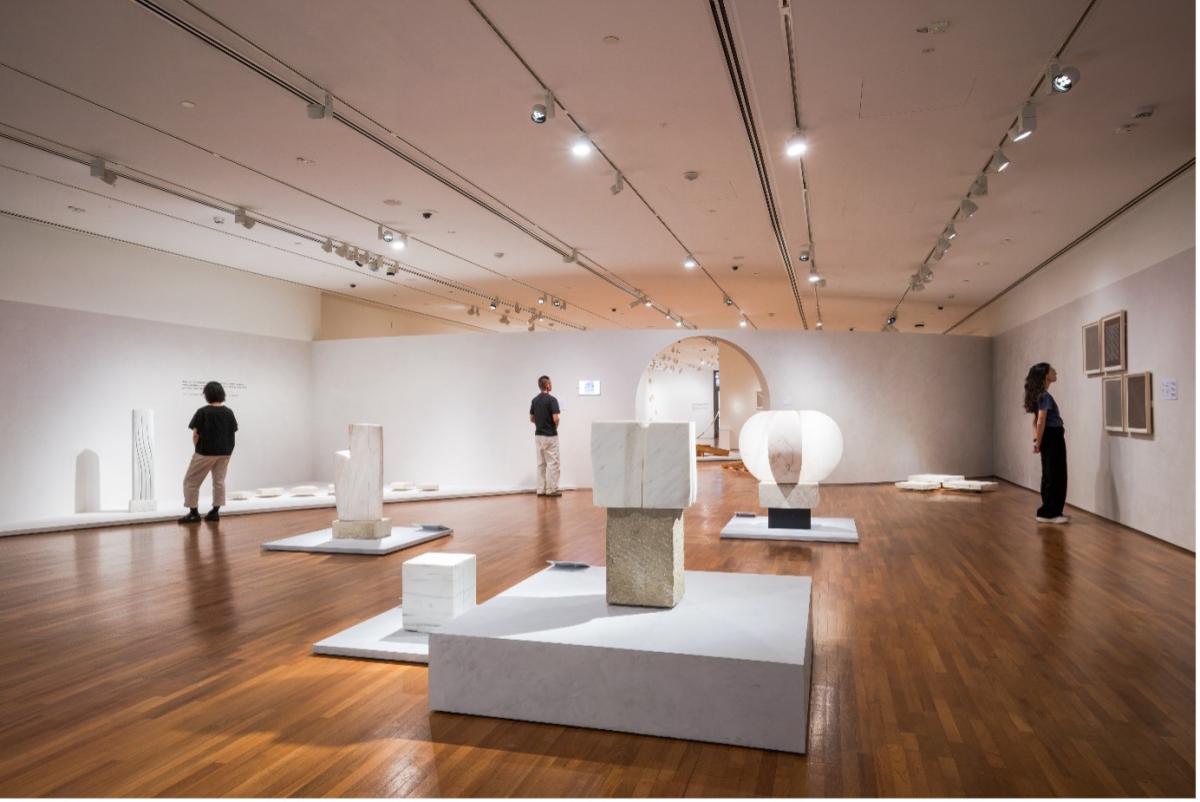
The exhibition concludes with works from Lim’s late period from 1979, a significant turning point in her practice. After working with wood, fibreglass, steel, and bronze for over twenty years, Lim shifted her focus to carving in stone. This change was sparked by her first survey exhibition in 1979 at the Roundhouse Gallery London, which made her “aware of the pull between the ordered, static experience, and the dynamic rhythms of organic structured forms.”. She turned to more organic forms, rhythms, and lines, distilling her observations of the natural world around her. Lim wanted to create metaphors that would “ricochet in the viewer and cross various boundaries of experience – to trigger responses beyond the object itself.”
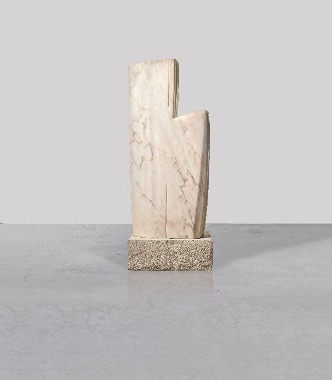
Kudah (1989) exemplifies Lim’s keen interest in using lines and contouring to define form and rhythm. Here, a more organic form replaces marble's typical architectural associations. Lim emphasised the stone's subtle qualities through gentle undulations and vertical incisions on its surface to create gentle contrasts of light and shadow. The sculpture appears as though a large block of stone has been sliced, with the remaining section suggesting the head and neck of a horse. Lim’s precise carving — one line extending from the base and another descending from the top — guides the viewer's gaze and introduces a rhythmic structure within the piece. The title Kudah refers to the Malay word for “horse” and evokes the knight in chess. Lim, who enjoyed playing chess with her husband, sculptor William Turnbull, often referenced chess pieces in her work from the late 1950s onward. Kudah, alongside other stone works from Lim’s late period, showcases Lim’s mastery of carving on stone and her enduring exploration of light and space as sculptural materials.
Understanding Lim's process of making and the ideas she kept close
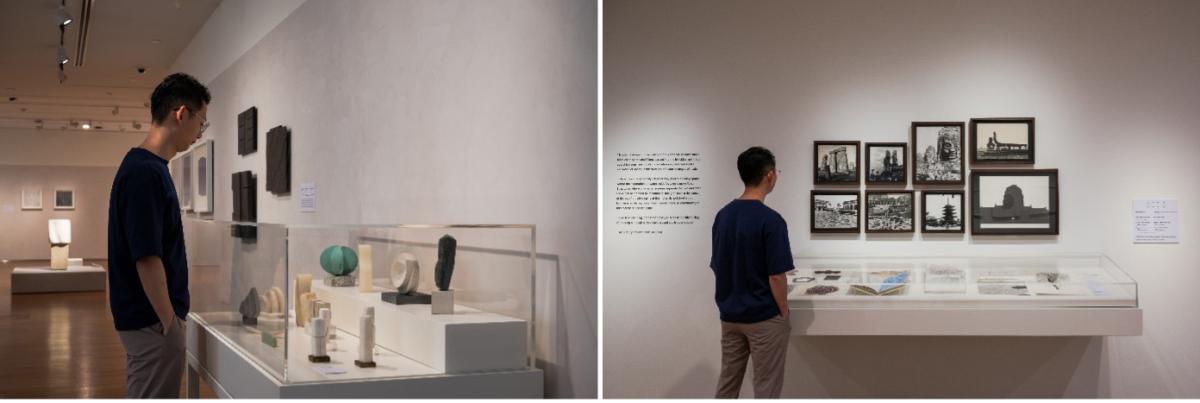
Visitors are also invited to delve into Lim’s artmaking process. The Space Between. A Retrospective unveils rarely displayed photographs and maquettes from Lim’s studio, offering insights into the ideas that the artist kept close. These elements are interwoven throughout the exhibition, enriching the viewer’s understanding of each section. Alongside her sculptures and prints, the displays include her maquettes, travel photographs, printing plates and wood blocks, sketchbooks, and studies. Although the artist preferred to convey meaning without straightforward representation, these materials reveal the profound influences of Lim’s travels and cosmopolitanism on her practice. This comprehensive view unveils new facets of Lim’s artistic practice, highlighting her innovative approach and enduring artistic legacy.
Kim Lim: The Space Between. A Retrospective runs from 27 September 2024 to 2 February 2025 at the Singtel Special Exhibition Galleries 2 & 3, Level 3, National Gallery Singapore. Visitors can purchase Special Exhibition Passes at $25 each ($15 for Singapore Citizens and Permanent Residents) which provides access to both Kim Lim: The Space Between. A Retrospective and Teo Eng Seng: We’re Happy. Are You Happy?.
Visitors can enjoy an early bird promotion of 10% off Special Exhibition or All Access Gallery Passes when booking through the Gallery’s website by 31 October 2024. Singtel subscribers and UOB cardmembers can also benefit from special discounts, with more details on their respective web pages and apps. Gallery Insiders enjoy free unlimited access to the exhibition.
More information can be found in the attached annexes, or you may visit nationalgallery.sg/kimlim. Media assets are available via this link.









